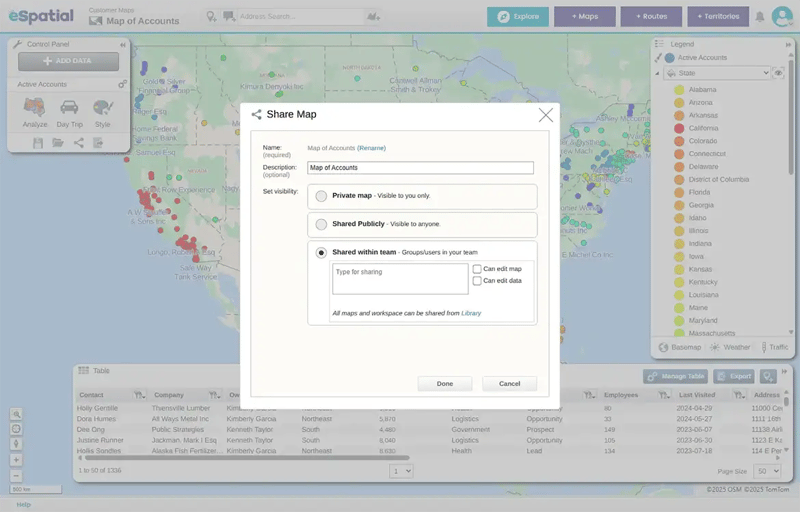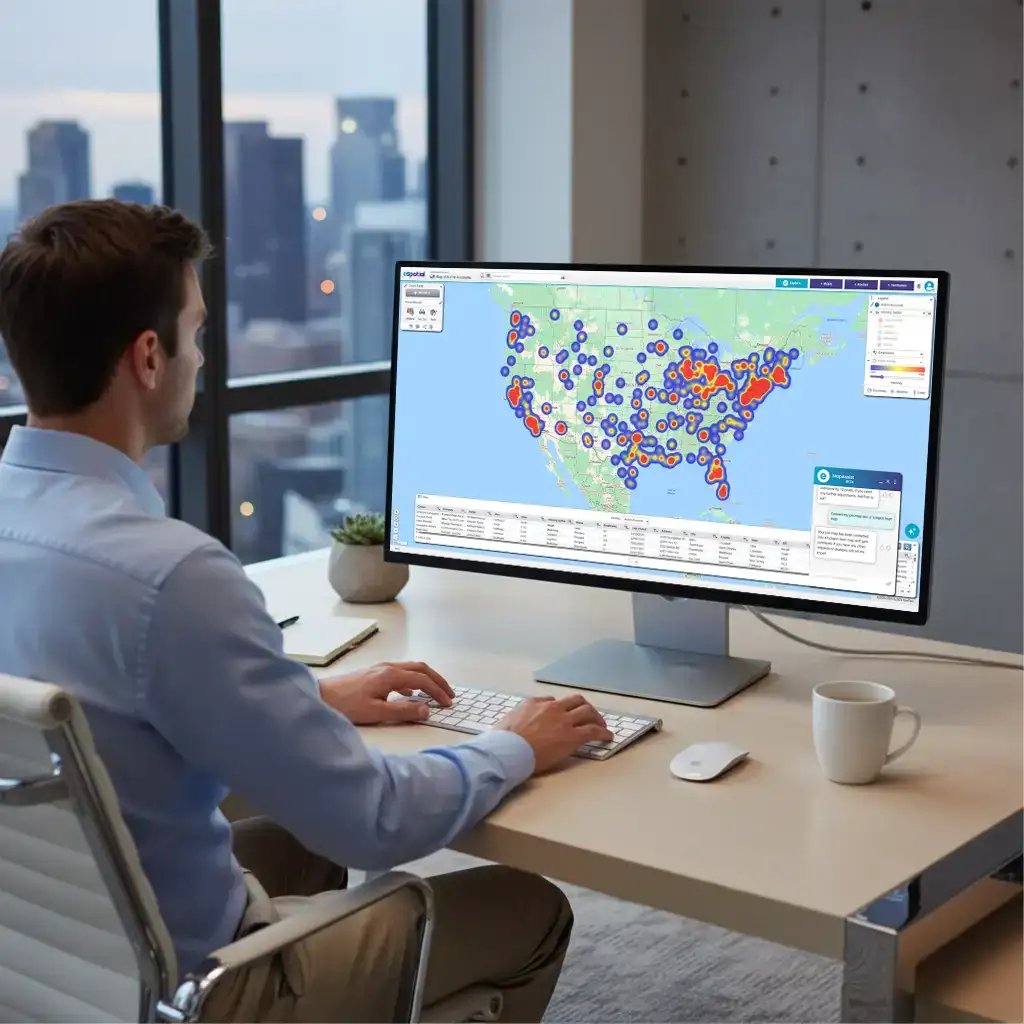Introduction
You have been there: staring at an endless spreadsheet of data, trapped by a single, critical C-suite question:
"Where should we launch our next campaign, and how can you prove it?"
Why it matters: You are asked to be a strategic partner, but your data is siloed in Salesforce, marketing automation, and dozens of files. This gap makes your job feel less like strategy and more like a manual, frustrating puzzle.
The Transformation
- Before: Data is a static list, trapping your best insights in spreadsheets.
- After: Data becomes a dynamic, visual map.
Imagine seeing, at a glance, where top customers are concentrated, where market "white space" exists, and which events are ripe for investment.
The bottom line: This guide is not theory. It is the most pragmatic, effective way to turn messy data into a strategic advantage that wins budget and gets leadership buy-in.
-
1. New reality
Why spreadsheets are slowing you down
View chapter about "1. New reality" -
2. Core concepts
How to get from
View chapter about "2. Core concepts"
data to decision -
3. Scenarios
Real-world scenarios for the Brand Guru
View chapter about "3. Scenarios" -
4. Features
What to look for in a mapping software
View chapter about "4. Features"
Chapter 1
The New Reality for Marketing Leaders Why You Need to Look Beyond the Spreadsheet

1. What is Mapping Software for Marketing Managers?
For marketing managers, mapping software is a powerful visualisation tool. It turns customer addresses, lead locations, and regional campaign performance into clear, actionable visuals.
Why it matters: Spreadsheets hide patterns; maps reveal them. You immediately transform complex data into strategic insights, seeing relationships that text or numbers could never show.
Visualize Your Edge
- Heatmaps pinpoint areas with high lead density or customer concentration
- Bubble maps scale campaign success by territory
- Color-coded maps instantly compare regional performance (e.g., green for goal achieved, red for underperforming)
The bottom line: Brevity is confidence. Use smart maps to stop guessing where your customers are and start conquering your market.

2. Why is It so Important for Your Business?
Your ability to find the right customer in the right location is the single greatest competitive advantage you can build. That's critical because without a clear visual view of your market, you are flying blind. You will waste budget and miss out on key growth opportunities.
The Two Core Risks
Map-based strategic planning immediately eliminates two major business risks:
- Wasted Spend: Stop pouring budget into markets that are already saturated or yielding diminishing returns
- Missed Opportunity: Identify large customer clusters in underserved territories that your rivals are ignoring
A disciplined market plan ensures you are not just generating leads; you are building a foundation for scalable growth.
This is how you:
- Scale Effectively: Design campaigns that support your business's true expansion plans
- Anticipate Change: Stay ahead of changing market dynamics so you are never caught off guard

3. The Old Way Versus the New Way
The old way is manual, frustrating, and prone to error.
The Old Way = Pain
It's an expensive patchwork of disconnected data sources that gives you snapshots, but no real-time insights:
- Manual & Prone to Error: Cross-referencing leads and postcodes with sales territories in Excel
- Instantly Outdated: The dreaded pivot table takes a full afternoon to build and is useless the moment you hit "save"
The New Way: Visual Command
The new way is visual, intuitive, and collaborative. It is taking all your data, from all of your sources, and instantly visualizing it on a map.
That's clarity. You see the big picture without the heavy lift. This shifts your time from data manipulation to strategic decision-making.
Smart Questions, Instant Answers
The new way lets you quickly answer your most critical questions:
- Customer Density: Which cities have a high concentration of our ideal customer profile?
- Sales Alignment: Are our marketing-generated leads aligning with our key sales territories?
- Market Gaps: Where is our geographic 'white space,' and how can we proactively target it?

4. Who Uses Mapping Software?
Mapping software is a game-changer for marketing leaders, demand-gen specialists, and analysts.
Why it matters: While sales and operations leverage it, marketing now uses it daily to drive confidence and decision-making across the C-suite.
The Marketing Toolkit: 4 Core Uses
Marketers use location data to eliminate data gaps and maximize performance:
- Analyse Opportunity: Identify new regions for campaigns and find untapped 'white space' markets
- Improve Strategy: Visualise lead location against existing customers and key sales territories
- Present Compellingly: Communicate complex campaign data and growth plans with simple visuals that get immediate buy-in
- Prove ROI: Justify marketing spend and budget requests by visualizing performance and customer clusters
The bottom line: This software is the bridge between your data and your strategic goals. It gives you the confidence to lead and communicate decisions to the C-suite.
How It Works
Step 1
Sign up & Upload
Your Data
Create a free account on our website, no credit card required. Then, upload your data from spreadsheets, CRMs, or other sources. eSpatial supports multiple file types, so you can get started quickly with minimal prep.

Step 2
Map And
Customize
Plot your data points like stores, clients, or assets on an interactive map. Use built-in filters, labels, and styling tools to highlight trends, customize views, and layer in details like sales territories or customer segments.

Step 3
Analyze And
Share Insights
Leverage powerful analytics to create heat maps, territory plans, or optimized routes. Easily share your visual insights through exportable formats or interactive maps to accelerate decision-making across your team.

Chapter 2
The Core Concepts of Mapping Software From Data to Decision

1. Getting Started With Your Data
The first step is often the hardest, but don't let it stop you: You already have the data you need.
Why care: Modern mapping software works with what you have. You can instantly turn a basic spreadsheet into your first strategic asset.
Where to start: Just upload your CSV or Excel file. The software handles the heavy lifting, automatically placing your points on a map. Look for these basic location data points:
- Customer Records: Postcodes or addresses from your datasets
- Lead Locations: Geographic data from your marketing automation tool
- Territory Data: The boundaries of your sales territories
- Event Log: Locations of past trade shows or marketing events
Go deeper: Don't wait for "perfect" data. Start with the basics to prove the value, and the data will follow.

2. The Power of Visual Data: Pin Maps, Heatmaps, and More
The real magic of mapping software lies in its ability to transform raw data into powerful visuals. Forget static pin maps; today's tools offer dynamic visualizations that provide instant insights:
- Pin maps: A basic but essential tool. A pin map simply shows the exact location of each data point, such as every key account in a given state.
- Heatmaps: These are your secret weapon. A heatmap uses color to show the density of your data points. Instantly see where leads for a new campaign are clustered or where valuable customers are concentrated.
- Color-coded maps: Shades a geographic area (e.g., postcode, state) based on a metric.. Visualize regional performance, such as shading by average contract value or total leads received.
- Bubble maps: Visualizes two data points at once (e.g., size by customer count, colour by industry). A powerful way to compare market factors and resource allocation simultaneously.

3. What Are the Benefits of Using Mapping Software?
The benefits are real and immediate, even if you're just starting out.
- Go from data to decision 95% faster: Stop wrestling with complex spreadsheets. Upload your data and see it all on an interactive map in minutes. This cuts analysis and planning time by up to 95%, freeing you up for more strategic work.
- Drive better business outcomes: By visualizing your data, you can uncover hidden growth opportunities and make decisions that increase revenue by up to 12% by ensuring you are targeting the right markets at the right time.
- Get buy-in from leadership: You can stop presenting numbers and start telling a visual story. An interactive map is far more compelling than a chart. You can easily show where customer hotspots exist and where your company needs to invest to align with market trends.
Chapter 3
Real-world Scenarios for the Brand Guru

Scenario 1: Market Analysis & Opportunity Identification
The problem: Your executive team wants to know where the next big market opportunity is. They’ve suggested a few cities, but you need data to back up a recommendation and justify the marketing spend.
The solution: You can use mapping software to layer several types of data onto a single map:
- Customer & lead data: Upload a CSV of customer and lead addresses from your Salesforce or marketing automation tool. Visualize them as heatmaps to see where your ideal profiles are concentrated.
- Sales territory data: Plot the boundaries of your key sales territories to see where you have coverage.
- Demographic/firmographic data: Pull in third-party data on industry, company size, or revenue. Visualize this using color-coded maps to identify areas that match your ideal customer profile.
The result: A powerful visual that shows you where your best customers are, where your sales team is, and where there are untapped markets ("white space"). This provides a clear, data-backed answer to the C-suite’s question.

Scenario 2: Event & Site Location Selection
The Problem: You need to plan the Q3 roadshow and justify the budget. You've always gone to New York and Chicago, but you have no data to prove they are still the best locations or to show the ROI.
The solution: You can map your current customers' locations using a pin map. You can then overlay a heatmap of your top prospects from Salesforce. Finally, plot the locations of potential event venues.
The result: You can instantly see which venue is within a 30-minute drive of the highest concentration of customers and prospects. This visual insight allows you to confidently defend your choice to leadership with a data-backed map, proving you are maximizing your event spend.

Scenario 3: Visualizing Data for Leadership & Sales Alignment
The problem: You've spent weeks compiling a report on campaign performance, but when you present it, your stakeholders are overwhelmed by the numbers and charts. Worse, the sales team is complaining that your leads are in the wrong territories.
The solution: Stop using static reports. Instead, use an interactive map. When you show leadership a color-coded map that clearly visualizes campaign ROI by region, it transforms a complex issue into an easy-to-understand strategic conversation. In the same meeting, you can overlay the sales territories to instantly see where marketing efforts and sales presence are misaligned, facilitating a productive conversation instead of a blame game.
The result: It's a shared language that ensures everyone is working from the same trusted information.
Chapter 4
What to Look for in a Mapping Software

1. Getting Your Data Onto the Map
The first thing to demand from your software is simplicity.
Why: Data upload must be frictionless. The best solutions handle the volume and complexity, so you can focus on strategy, not logistics.
Three Non-Negotiables
Look for a solution that provides these core functions:
- Easy Upload: Must accept common formats, like your daily CSV and Excelfiles
- Auto-Geocoding: Converts addresses or postcodes to map coordinates automatically
- Volume Ready: Handles your current and future data volume without crashing
The bottom line: If the software makes it hard to upload your data, it's not worth your time.

2. The Ability to Create Data Visualizations
The software must provide simple, intuitive control over all visual formats.
Why it matters: You need the power to instantly segment data by any field—industry, lead source, or annual revenue—to see immediate strategic results.
Core Visual Control
The platform should allow you to create and edit all key visual types easily:
- Custom Maps: Full control over Pin Maps, Heatmaps, Bubble Maps, and Colour-Coded Maps
- Dynamic Segmentation: Segment your data based on any field you upload (e.g., industry, revenue, lead source)
- Instant Insight: See the visual results of your segmentation instantly
The bottom line: Simple controls and dynamic segmentation are the core functionality required for effective strategic decision-making.

3. Holistic View: Overlay Everything
Your go-to-market strategy is complex. Your mapping software should not be.
Why it matters: Simplicity unlocks holistic insight. You must be able to view all your key data sets simultaneously on a single map to gain a strategic view of your entire market.
The Single-Map Advantage
Look for a solution that allows you to easily overlay multiple data sets:
- Customers
- Marketing Leads
- Sales Territories
The bottom line: Overlaying data replaces guesswork with visual certainty. This is the key to connecting sales and marketing efforts.

4. The AI Advantage: Next-level Speed
AI is now embedded in mapping software to help you accomplish everything faster and more reliably.
Why it matters: You get more done in less time. Artificial Intelligence acts as an assistant that maximizes your efficiency and minimizes human error.
Key Questions to Ask a Mapping Software Vendor
Question 1
How Much Does It Cost?
How much does it cost? A good vendor will be completely transparent about their pricing.
Why it matters: Your budget is finite. You must understand the total cost before signing on, ensuring there are no hidden fees that derail your ROI later.
Three Core Pricing Questions
Use these questions to challenge any vendor and ensure clarity:
- Tiers & Scale: Are there different subscription tiers? Are these based on user count or features?
- Hidden Fees: Are there any hidden charges for professional services, data uploads or advanced features (e.g., AI)?
- Total Cost: What is the all-in annual cost, and is it locked in?
The bottom line: Demand full clarity on price and features. No transparency, no deal.
Question 2
Your Time is Finite: Demand Expert Support
You do not have time to become a mapping expert. You need a solution that is easy to use and a vendor who provides excellent support.
Why it matters: Friction kills adoption. A reliable vendor must be ready with both intuitive software and rapid, high-quality support to keep your strategic projects on track.
The Support Test
Ask these three core questions to gauge a vendor's commitment to your success:
- Training Access: What training resources are provided, and are they available on-demand?
- Support Channels: What customer support channels are offered (phone, email, chat)?
- Response Speed: What is the guaranteed response time? How quickly can you expect a fix or answer?
The bottom line: A great tool is only as good as the support behind it. Demand a vendor that respects your time and expertise.
Question 3
Deployment: Choose Cloud Flexibility
Modern software deployment is simple: Cloud-based is the only scalable option.
Why it matters: Deployment must support modern work. A web-based solution means you can access your maps from anywhere, on any device, ensuring seamless collaboration and presentation.
The Collaboration Edge
Cloud-based deployment is crucial for:
- Remote Teams: Instantly share and collaborate on live data, regardless of physical location
- Executive Access: Present to the C-suite on the go with guaranteed access to the latest map views
The bottom line: Flexibility and universal access eliminate friction and maximize the value of your strategic visuals.
Question 4
Data is Sensitive: Security is Non-negotiable
As a marketing leader, you are responsible for sensitive customer and lead data. You must ensure the software is secure.
Why it matters: Trust is your most valuable asset. A security breach means legal, financial, and reputational ruin. Vet your vendor to ensure data is protected.
The Security Checklist
Demand definitive answers to these three core questions:
- Protocols: What specific security protocols govern the platform and data storage?
- Encryption: Is customer and lead data protected by end-to-end encryption?
- Third-Party Vetting: Have they undergone recent, independent third-party security audits?
The bottom line: Never compromise on security for convenience. If a vendor cannot provide clear, immediate answers on data protection, >walk away.
Question 5
Scalability: Check Your Technical Limits
You must confirm two core technical capabilities: data geocoding and upload limits.
Why it matters: Your marketing database will grow. You need a solution that can scale with your organization, not one that imposes hidden, expensive constraints on your growth.
Two Non-Negotiable Limits
Demand clarity on these key operational constraints:
- Geocoding: This is converting addresses into map coordinates. Does the software offer unlimited geocoding?
- Data Volume: Are there any limits on the amount of data you can upload to the platform?
The bottom line: Technical limitations today become growth barriers tomorrow. Invest in a solution designed for future scale.
Question 6
The Vendor Vetting Checklist
When choosing a vendor, these six core questions separate a future partner from a costly constraint.
Why it matters: You are investing in a system to last. The software must handle your current data needs while guaranteeing future speed, scalability, and security.
6 Non-Negotiable Questions
Demand clear, definitive answers to these operational queries:
- Performance: How quickly does the map refresh? Can it handle large data volumes without slowing down?
- Scalability: Can the system scale with your needs as your company grows?
- Future-Proofing: How often are new features released? Are they automatically available?
- API / Integration: Can the system integrate seamlessly with your existing Salesforce or marketing automation tool to reduce manual work?
- Mobility: Can you access your maps from any device (phone, tablet)?
- Single Sign-On (SSO): Does the software support SSO for a secure, seamless login?
The bottom line: A great map tool is a strategic asset. If a vendor cannot commit to performance, scale, and integration, move on.
The Future
For too long, marketing planning has been a frustrating, numbers-driven exercise, trapping your best insights in spreadsheets. It does not have to be.
Why it matters: Moving beyond the spreadsheet transforms your role. You shift from a tactical data wrangler to a strategic partner who tells compelling visual stories.
The Three Wins
Adopting mapping software is the most pragmatic and effective way to turn your data into a visual story that delivers:
- Leadership Buy-In: Present compelling visuals that instantly secure agreement from the C-suite
- Budget Victory: Win resources for your best ideas by proving their geographic and strategic value
- Future Growth: Proactively prepare your organization for future market expansion

